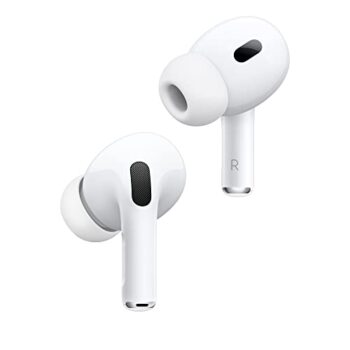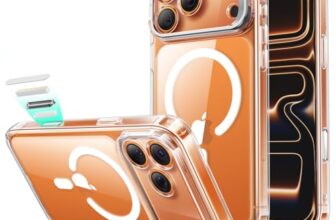Apple AirPods Pro 2 (USB-C) Technical Review: A Masterclass in Computational Audio and Personal Intelligence
Introduction: The Evolution from Wireless Audio to a Personal Sensory Interface
In the fiercely competitive arena of personal audio, the term “wireless earbuds” has become an oversimplification, a relic of a time when cutting the cord was the primary innovation. Today’s flagship devices are no longer just about listening to music; they are sophisticated computational platforms, complex sensory interfaces that mediate our relationship with the world’s soundscape. It is in this advanced context that the Apple AirPods Pro 2 must be understood. This is not merely an iteration of a successful product; it is the culmination of years of relentless research and development in silicon engineering, psychoacoustics, and machine learning. It represents a profound statement from Apple: the earbud is no longer a passive accessory, but an active, intelligent partner in your auditory life.
The AirPods Pro 2, now updated with a versatile USB-C charging case, are built upon the foundation of a new, immensely powerful brain: the Apple-designed H2 chip. This custom silicon is the engine that drives a suite of features so advanced they blur the lines between a listening device, a communication tool, and a hearing health product. It powers an Active Noise Cancellation system that is not just stronger but smarter, capable of silencing twice the amount of background noise while intelligently adapting to your environment in real-time. It orchestrates a high-fidelity audio experience that is not just immersive but deeply personal, using your unique ear shape to create a three-dimensional soundstage with Personalized Spatial Audio. And in a groundbreaking move, it unlocks a pioneering all-in-one hearing health experience, integrating scientifically validated testing and active protection into the device you use every day. This is a product that promises not just to play your music with stunning clarity, but to actively manage the sound of your world for a better, safer, and more engaging experience. And with a limited-time 32% discount, the barrier to entry for this top-tier technology has never been lower.
This exhaustive technical review will perform a granular dissection of the technologies that define the AirPods Pro 2. We will deconstruct the complex algorithms behind the H2 chip’s intelligent noise control, analyze the biomechanics of Personalized Spatial Audio, evaluate the real-world performance of its advanced audio drivers and microphone arrays, and explore the seamless integration that makes this product the undisputed benchmark in the wireless audio space. This is a deep dive for the discerning user who demands to understand the science behind the magic.

A Deep Dive into the Key Features: A Component-by-Component Technical Analysis
The AirPods Pro 2’s market-leading performance is not derived from a single feature but from the deeply integrated and synergistic operation of its advanced hardware and software components, all orchestrated by the H2 chip. Let’s analyze each core technology from a technical perspective.
-
Intelligent Noise Control: A Multi-Layered Computational Approach
The claim of Active Noise Cancellation (ANC) that removes “up to 2x more background noise” is the result of a complete system overhaul. The ANC in AirPods Pro 2 is a closed-loop, feed-forward and feed-back system. Here’s the technical breakdown:
- Feed-Forward Cancellation: An outward-facing microphone on each earbud samples the external ambient noise. The H2 chip’s algorithm analyzes this soundwave, inverts its phase by 180 degrees, and generates an “anti-noise” signal.
- Feed-Back Cancellation: An inward-facing microphone, positioned inside your ear canal, listens for any noise that has leaked past the passive seal of the silicone tip, as well as any internal resonances. It provides a real-time feedback loop to the H2 chip, which then fine-tunes the anti-noise signal with incredible precision.
The H2 chip’s ability to process audio at 48,000 times per second is the key to the 2x improvement. This immense computational power allows it to analyze and cancel a much wider range of frequencies with greater speed and accuracy, particularly in the mid-range where human voices reside. This is complemented by new, optimized acoustic vents and microphone placements that provide a cleaner initial signal to the processor.
Adaptive Audio is the system’s most intelligent evolution. It is not a separate mode but a dynamic blending of ANC and **Transparency Mode**. Using machine learning models running on the H2 chip, the device continuously analyzes your environment. In a quiet office, it may allow more ambient sound through. If a loud siren or construction noise suddenly appears, it will seamlessly and instantly ramp up the level of noise cancellation to protect your hearing and maintain your focus, then ease off again once the loud noise has passed. The most impressive part of this is **Conversation Awareness**. When the system’s microphones detect that you are speaking, it uses a combination of voice-pickup from the accelerometers and beamforming mics to confirm you are in a conversation. It then automatically lowers the volume of your media, reduces background noise, and enhances the voices of the people in front of you. This is an incredibly complex real-time audio processing feat that makes interactions seamless without ever needing to touch a control.

-
Acoustic Architecture: The H2 Chip, Custom Drivers, and Voice Isolation
The “Improved Sound and Call Quality” stems from a completely redesigned audio pipeline. The Apple-designed H2 chip is the conductor, managing the entire process. It works in concert with a new low-distortion, custom-built driver and a custom amplifier. From a technical standpoint, “high-fidelity” sound is about reproducing the original audio signal with the lowest possible distortion across the entire frequency spectrum. The H2 chip’s power allows for more advanced computational audio algorithms, including a sophisticated Adaptive EQ. The inward-facing microphone measures what you are actually hearing in real-time, and the H2 chip adjusts the low and mid-frequencies to account for the unique fit and seal of the tips in your ear, ensuring a consistent and rich audio experience.
The driver itself boasts high excursion, meaning the diaphragm can move a greater distance. This allows it to move more air, which is the key to producing “full, rich bass” with authority and without distortion, even at high volumes. Simultaneously, its rigidity allows it to respond incredibly quickly to the signal, which is essential for reproducing “crisp, clear high notes” with stunning definition and without smearing. For call quality, the system uses a technology called **Voice Isolation**. This leverages the beamforming capabilities of the microphone array. The microphones work together to create a narrow directional “beam” focused on your mouth, while the H2 chip uses machine learning to identify and aggressively suppress all other non-vocal ambient noise. This is what allows you to have a crystal-clear phone call even in a loud, windy environment.

-
Biomechanics and Psychoacoustics: Personalized Spatial Audio
Personalized Spatial Audio is one of the most scientifically advanced features in personal audio today. Standard stereo audio is two-dimensional. Spatial Audio aims to create a three-dimensional, theater-like experience where sound feels like it’s coming from all around you. The “Personalized” aspect is the key innovation. How we perceive the direction of sound is heavily influenced by the unique physical shape of our head and ears. This is described scientifically by a Head-Related Transfer Function (HRTF). Apple uses the **TrueDepth camera on an iPhone** to create a detailed 3D scan of your ear’s geometry. This data is used to generate a unique, personal HRTF for you.
When you listen to spatialized content (including **Dolby Atmos** tracks), the H2 chip applies this personal HRTF to the audio signal in real-time. This tailors the sound to your specific anatomy, dramatically increasing the accuracy and immersiveness of the 3D effect. The experience is further enhanced by **dynamic head tracking**. Using the gyroscopes and accelerometers built into the AirPods, the system tracks the precise movement of your head relative to your device (like an iPhone or iPad). As you turn your head, the H2 chip remaps the sound field so that the audio remains “anchored” to the device, creating the uncanny illusion that the sound is coming from the screen itself, not from your earbuds. This complex interplay of biomechanical scanning, psychoacoustic modeling, and real-time motion tracking delivers an “immersive listening experience that places sound all around you” with a level of realism that is simply breathtaking.

-
Advanced User Interface: Touch Control and Siri Interactions
Apple has enhanced the physical and virtual interface for a “higher level of control.” The stem of each AirPod Pro now includes a capacitive **Touch control** layer. This sensor can detect not only presses and holds (for switching modes or answering calls) but also vertical swipes. This allows for intuitive, on-the-go volume adjustment by simply sliding a finger up or down the stem, a small but massively convenient feature. A new, more advanced feature is **Siri Interactions**. This leverages the motion-detecting accelerometers inside the AirPods. When a notification or call comes in and Siri announces it, the user can simply **nod their head yes or shake their head no** to accept or decline, without needing to speak or touch a device. This is a powerful accessibility feature and a glimpse into a more seamless, gesture-based future for personal computing.

-
The Ecosystem Hub: The “More Capable” Charging Case
The charging case has evolved from a simple battery pack into a sophisticated device in its own right. Its most significant upgrade is the integration of Apple’s **U1 Ultra Wideband (UWB) chip**, the same technology found in AirTags. This enables **Precision Finding** within the Find My app. Unlike standard Bluetooth tracking which gives you a general location, UWB allows for highly accurate, directional guidance, with your iPhone pointing you directly to the case’s exact location, down to the inch. To aid in this, the case now includes a **built-in speaker** that can play a louder, more distinct sound to help you locate it. This speaker also provides audible feedback for low battery and pairing confirmation. The addition of a **lanyard loop** is a simple but highly requested physical feature for added security. Finally, the case offers unparalleled charging versatility. The new model features a universal **USB-C port**, but it also retains wireless charging compatibility with **Apple Watch chargers, MagSafe chargers, and standard Qi-certified chargers**, ensuring you can power it up with virtually any modern charging accessory.

Pros: The Undeniable Technical Strengths
- Class-Leading Noise Control: The H2-powered ANC is demonstrably more powerful and intelligent than the competition, and the Adaptive Audio/Conversation Awareness features are game-changing.
- Superb High-Fidelity Audio: The combination of the H2 chip, a new low-distortion driver, and Adaptive EQ delivers a rich, detailed, and consistently excellent sound signature.
- Revolutionary Spatial Audio: The “Personalized” aspect using a 3D ear scan is a genuine technological leap, providing an incredibly immersive and accurate 3D sound experience.
- Exceptional Call Quality: The Voice Isolation feature, powered by advanced beamforming and machine learning, provides crystal-clear call quality even in very noisy environments.
- Vastly Improved User Interface: The addition of on-stem volume control via swiping is a massive quality-of-life improvement, and Siri Interactions add a new layer of hands-free convenience.
- A Truly “Smart” Case: The integration of the U1 chip for Precision Finding, a built-in speaker, and universal charging options (including USB-C) make the case a powerful and convenient part of the ecosystem.
- Pioneering Hearing Health Features: The integration of scientifically validated hearing tests and active protection is a groundbreaking step in personal health technology.
- Robust Durability: The IP54 rating for both the earbuds and the case provides reliable resistance to dust, sweat, and water for workouts and daily use.

Cons: Important Technical Considerations and Limitations
- Ecosystem Lock-In: To access the full suite of advanced features, particularly Personalized Spatial Audio and seamless device switching, a user must be invested in the Apple ecosystem (iPhone, iPad, Mac).
- Limited High-Resolution Codec Support: The AirPods Pro 2 rely on the standard AAC Bluetooth codec. They do not support higher-bandwidth codecs like aptX HD or LDAC, which can theoretically transmit higher-resolution audio from non-Apple devices.
- No User-Adjustable Equalizer (EQ): While the Adaptive EQ works exceptionally well, Apple does not provide a manual multi-band equalizer within the settings for users who want to fine-tune the sound signature to their specific tastes.
- Premium Price Point: Despite discounts, they remain a premium-priced product, representing a significant investment compared to many other high-quality wireless earbuds on the market.
Conclusion: The Undisputed Benchmark for Intelligent Personal Audio
The Apple AirPods Pro 2 (USB-C) are a technical tour de force and a resounding statement of Apple’s dominance in the wearable technology space. They are a product that feels less like an accessory and more like an extension of the user’s own senses. The sheer computational power of the H2 chip delivers a suite of intelligent features that are not just impressive on a spec sheet but are profoundly impactful in daily use. The Active Noise Cancellation is not just better; it’s smarter, more adaptive, and fundamentally changes how you experience noisy environments. The audio quality is not just high-fidelity; it’s personalized, immersive, and capable of creating an astonishingly realistic three-dimensional soundscape. And the expansion into a genuine hearing health platform is a visionary move that adds a layer of purpose and value that no competitor can currently match.
While the experience is undeniably optimized for those within the Apple ecosystem, the sheer performance of the core features—the ANC, the sound quality, the comfort—makes them a compelling choice for any user. They are a product of a thousand thoughtful details, from the swipe volume control on the stem to the U1 chip in the case. The AirPods Pro 2 are not just the best wireless earbuds Apple has ever made; they are the definitive benchmark for the entire category of intelligent personal audio. For the user who demands the most advanced technology, the most seamless user experience, and a product that actively improves their daily interaction with sound, the AirPods Pro 2 are an unequivocal and top-tier recommendation.
Frequently Asked Questions (FAQs)
- Q1: How does the H2 chip technically make the Active Noise Cancellation “2x better”?
- A: The “2x better” claim is based on the H2 chip’s massive increase in computational power. It can process audio data at 48,000 times per second, a huge leap over the H1 chip. This allows its noise-cancellation algorithm to run with greater complexity and speed. It can more accurately identify and generate the “anti-noise” signal for a much wider range of frequencies, especially in the difficult mid-range (like human voices or office chatter), and it can adapt to changes in the noise environment almost instantaneously, resulting in a deeper and more consistent level of silence.
- Q2: What is the technical difference between “Adaptive Audio” and just using ANC or Transparency mode?
- A: ANC and Transparency are static modes that you manually select. Adaptive Audio is a dynamic, intelligent mode that uses machine learning to automatically and seamlessly blend the two. It continuously analyzes your surroundings. In a quiet library, it might operate closer to Transparency mode. If a loud vacuum cleaner starts up, it will instantly ramp up the ANC to cancel that specific noise, then return to a more transparent state once the noise is gone, all without you touching a single control.
- Q3: How exactly does “Personalized Spatial Audio” work? Is it a gimmick?
- A: It is not a gimmick; it’s based on a scientific principle called Head-Related Transfer Function (HRTF). The way you perceive the direction of sound is unique to the physical shape of your ears. The feature uses your iPhone’s TrueDepth camera to create a 3D model of your ear. This data is used to create a custom audio filter (your personal HRTF) that the H2 chip applies to the sound. This makes the 3D audio effect significantly more accurate and immersive because it’s tailored to your specific anatomy.
- Q4: What does the IP54 rating technically mean for durability? Can I swim with them?
- A: No, you cannot swim with them. The IP54 rating is a standard for ingress protection. The ‘5’ means they are protected against dust ingress (not fully dust-tight, but enough to prevent interference with operation). The ‘4’ means they are protected against water splashes from any direction. This makes them perfectly safe for heavy sweating during a workout, running in the rain, or getting accidentally splashed, but they are not designed to be submerged in water.
- Q5: What is the U1 chip, and how is “Precision Finding” different from the regular “Find My” for older AirPods?
- A: The U1 chip is Apple’s Ultra Wideband (UWB) radio chip. Regular “Find My” uses Bluetooth, which can tell you if you are generally “near” your lost item (within about 30 feet). UWB is a much more precise location technology. It allows your iPhone (which also has a U1 chip) to determine the exact distance and direction to the AirPods case. The Find My app then displays an arrow on your screen pointing you to its exact location, down to a matter of inches—as if you’re using a digital compass.
- Q6: Why did Apple switch to USB-C, and does it charge faster?
- A: Apple switched to USB-C primarily to comply with new European regulations mandating a common charging standard and to unify the charging port across their entire product line (Macs, iPads, and now iPhones and AirPods). The USB-C port on the case itself does not necessarily enable faster charging for the case or the AirPods within it; the charging speed is still governed by the case’s internal power management circuitry. The main benefit is the convenience of using the same cable for all your modern devices.
- Q7: Will I get the same sound quality and features if I use these with an Android phone?
- A: You will not get the full experience. You will still get the excellent core audio quality and the top-tier Active Noise Cancellation and Transparency modes, which are handled by the H2 chip internally. However, you will lose all the deep ecosystem features that rely on Apple’s software, including Personalized Spatial Audio, automatic device switching, “Hey Siri” activation, and the advanced Find My capabilities. They will function as a high-quality, standard pair of Bluetooth earbuds.
See more posts in the category Headphones.







